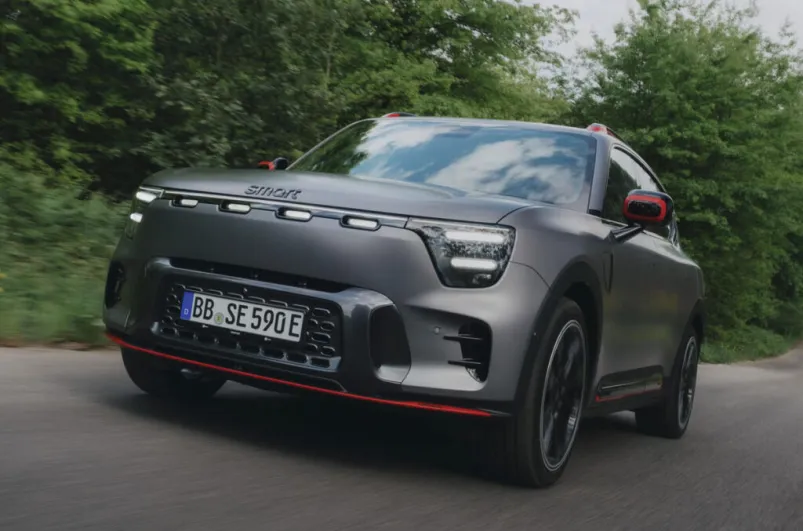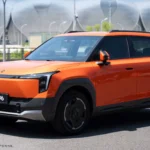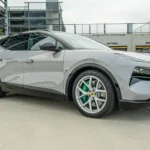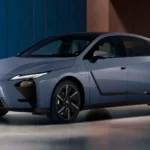This week is marked by significant shifts across the automotive and technology landscapes. Smart, a brand once synonymous with compact urban vehicles, is making an audacious leap into larger electric SUVs. Simultaneously, President Donald Trump has issued a powerful warning to Apple, potentially impacting global iPhone production.
Further breaking news includes intriguing details about OpenAI’s clandestine hardware project with Jony Ive, a pivotal moment for Chinese EV giant BYD in the European market, and new health-focused features for Garmin smartwatches. The regulatory sphere also saw a major development with the Federal Trade Commission’s decision on a high-profile tech merger.
Smart #5 EV: Redefining the Brand’s Identity
Smart, traditionally known for its diminutive two-door Fortwo and slightly larger Forfour city cars, is undergoing a radical and strategic rebranding. Its all-electric future is taking an unexpected turn, prioritizing spaciousness and versatility over ultra-compact dimensions.
A New Era of Electric Vehicles
The journey began with the Smart #1, which debuted as a compact electric crossover. This marked a departure from the brand’s micro-car roots, signaling an intent to appeal to a broader market segment. Following this, the Smart #3 arrived, essentially a sleeker, coupe-ified version of the #1, offering a slightly more dynamic profile while retaining the crossover form factor. Now, the unveiling of the Smart #5 completes this transformation.
This vehicle eradicates any lingering perception of Smart as solely a maker of small, urban-centric automobiles.
Unprecedented Scale and Market Position
The Smart #5 EV is, unequivocally, the largest vehicle the brand has ever produced. Its dimensions are substantial: nearly 4.7 meters (approximately 185 inches) in length, 1.9 meters (around 75 inches) wide, and 1.7 meters (about 67 inches) tall. To provide a clear context of its size, the #5 is even slightly larger in every direction than the Škoda Enyaq, a well-established and popular electric SUV in the European market.
This significant increase in size positions the Smart #5 to directly compete in the fiercely competitive mid-size electric SUV segment, appealing to families and buyers seeking more interior space and utility. Its design language also reflects a more rugged, adventurous aesthetic, suggesting a move beyond purely urban environments. This strategic shift aims to capture a larger share of the rapidly expanding global EV market.
Trump’s Bold Threat to Apple’s iPhone Production
President Donald Trump has issued a forceful and direct warning to technology giant Apple, signaling a potential seismic shift in global manufacturing strategies for the iconic iPhone.
The Looming 25% Tariff
Trump’s threat involves imposing a substantial tariff of “at least 25%” on iPhones. This proposed import tax would specifically target all iPhones not manufactured within the United States. This aggressive stance comes on the heels of recent strategic announcements from Apple. Apple CEO Tim Cook had previously outlined a significant diversification of the company’s production bases. The majority of iPhones destined for the crucial U.S. market are now slated for manufacturing in India.
Furthermore, production of iPads and Apple Watches has been primarily shifted to Vietnam.
Demand for Domestic Manufacturing
Trump made his expectations unequivocally clear through his public statements. He asserted, “I have long ago informed Tim Cook of Apple that I expect their iPhones that will be sold in the United States of America will be manufactured and built in the United States, not India, or anyplace else.”
This powerful declaration underscores his persistent “America First” agenda, emphasizing the repatriation of manufacturing jobs to the U.S. Such a tariff, if implemented, could have profound implications for Apple’s intricate global supply chain, potentially leading to increased production costs, adjustments in retail pricing for consumers, and a major re-evaluation of its international manufacturing footprint. The tech industry watches closely for any further developments on this front.
OpenAI and Jony Ive’s Secretive AI Device
OpenAI, the leading artificial intelligence research and deployment company, is embarking on a fascinating hardware venture in collaboration with Jony Ive, the legendary former chief design officer of Apple. Details about this highly anticipated and mysterious device are gradually emerging.
A Screen-Free, Contextually Aware Companion
Ive and OpenAI CEO Sam Altman recently shared preliminary insights into the project during an internal staff call. These details were later reviewed by The Wall Street Journal. The device is described as pocket-sized, emphasizing portability and personal utility. Crucially, it will be contextually aware, meaning it can understand and adapt to its surrounding environment and the user’s needs.
A key design departure is its screen-free interface, suggesting a focus on voice interaction and ambient intelligence. Furthermore, it has been explicitly stated that the device is not eyewear, ruling out augmented reality glasses. This hints at a new form factor for AI-powered personal technology.
Strategic Vision and Trillion-Dollar Potential
These revelations follow OpenAI’s significant $6.5 billion acquisition of Ive’s new AI hardware startup, io. This substantial investment underscores the seriousness of OpenAI’s hardware ambitions. Altman himself suggested that this strategic acquisition could potentially elevate OpenAI’s valuation by an astounding $1 trillion, indicating immense confidence in the project’s disruptive potential.
He also envisioned this partnership as the genesis of a broader “family of devices,” suggesting a long-term strategy for integrating advanced AI into various consumer hardware products. This collaboration merges OpenAI’s cutting-edge AI capabilities with Ive’s unparalleled expertise in minimalist and intuitive product design, promising a truly innovative user experience.
BYD’s Historic Triumph Over Tesla in European EV Sales
In a remarkable shift in the electric vehicle (EV) market landscape, Chinese automotive giant BYD has achieved a significant milestone: for the first time, it has outsold Tesla in Europe. This event has been widely described by industry experts as a “watershed moment.”
A New Leader in European EV Sales
According to comprehensive research conducted by Jato Dynamics, BYD successfully sold 7,231 electric vehicles across the European Union (EU) and the United Kingdom during April. This figure, though seemingly modest, slightly surpassed Tesla’s sales of 7,165 units within the same timeframe. This narrow lead represents a monumental achievement for BYD. The Chinese brand only initiated its aggressive expansion across the European continent in 2022.
In just over two years, BYD has rapidly established a formidable presence, now directly challenging more established Western carmakers like Volkswagen, Stellantis, and even Tesla itself.
Factors Behind BYD’s Rapid Ascent
BYD’s rapid ascent in Europe can be attributed to several strategic factors. The company offers a diverse and increasingly attractive range of EV models, from compact hatchbacks to larger SUVs and sedans, often at highly competitive price points. This broad appeal caters to a wider consumer base than Tesla’s more focused luxury offerings. Furthermore, BYD has invested heavily in establishing a robust dealer network and after-sales support across Europe, building consumer confidence.
Their vertical integration, manufacturing everything from batteries to semiconductors, also gives them a significant cost and production advantage. This shift underscores a growing competitiveness in the global EV market, with Chinese manufacturers increasingly proving their capabilities beyond their domestic borders.
Garmin’s Significant Smartwatch Software Update
Garmin, a leader in GPS technology and wearable devices, has quietly rolled out a substantial new software update. This update targets a wide range of its latest smartwatches and delivers more than just routine bug fixes.
Enhanced Health Monitoring Features
The comprehensive update is being deployed across several of Garmin’s most popular and advanced models. This includes the high-end Fenix 8 series, various devices within the Forerunner series (popular among runners), the rugged new Instinct 3, the stylish Lily 2 Active, and the versatile Venu 3. The update introduces several new health and fitness functionalities designed to provide users with deeper insights into their well-being.
One of the key new features is “Breathing Variations.” This function utilizes the watch’s Pulse Ox sensor to meticulously track and analyze a user’s respiratory patterns during sleep. This provides valuable data for understanding sleep quality and overall respiratory health. Another notable addition is the innovative “Rucking Activity mode.”
This mode is specifically designed for tracking weighted hiking, a popular form of exercise. It includes support for accurately inputting the weight of the user’s pack, allowing for more precise calorie burn calculations and performance metrics for this demanding physical activity. These updates reinforce Garmin’s commitment to delivering advanced health and fitness tracking capabilities, appealing to both casual users and serious athletes.
FTC Drops Microsoft-Activision Blizzard Merger Challenge
The U.S. Federal Trade Commission (FTC), a key regulatory body, has officially withdrawn its long-standing legal challenge. This case aimed to block Microsoft’s colossal $69 billion acquisition of Activision Blizzard, the highly successful video game publisher known for franchises like Call of Duty, World of Warcraft, and Candy Crush.
End of a Lengthy Legal Battle
The FTC announced its decision on Thursday, concluding a lengthy and complex legal battle that spanned multiple continents. The agency stated that pursuing the case against the already completed deal was “not in the public interest.” This strategic withdrawal effectively removes the final significant regulatory hurdle in the United States for Microsoft’s acquisition.
The deal had already closed after receiving approvals from major regulatory bodies worldwide, including the European Union and the UK’s CMA, albeit after some concessions from Microsoft regarding cloud gaming rights.
A Shift in Regulatory Focus
This decision comes amid reports that FTC Chair Andrew Ferguson is re-evaluating the agency’s enforcement priorities. Ferguson is reportedly seeking to align the FTC’s resources with agendas that complement President Donald Trump’s priorities. This includes a notable shift towards potential investigations into areas such as alleged collusion among advertisers to reduce spending on the social media platform X (formerly Twitter).
The dropping of the high-profile Microsoft-Activision case signals a potential strategic realignment within the FTC, moving away from past antitrust challenges to focus on new areas of concern, reflecting evolving political and economic objectives. This decision has significant implications for future tech mergers and the broader regulatory landscape.








